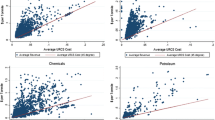Abstract
Railroad deregulation has had tremendous effects on the level of costs and productivity gains. I use an unbalanced panel of railroads from 1978 through 1989 to estimate a translog cost function. I find that initially cost savings from partial deregulation were modest. However, by 1989, I find that cost savings were tremendous, with costs being up to 40 percent lower than they would have been under regulation. I also find that while initial effects of deregulation on productivity gains were large, these effects have fallen through time, and currently are comparable to pre-deregulation levels.
Similar content being viewed by others
References
Armstrong, J. H. 1978. The Railroad—What It Is, What It Does. Omaha: Simons-Boardman.
Atkinson, S. E. and J. Kerkvliet. 1986. “Measuring the Multilateral Allocation of Rents: Wyoming Low Sulfur Coal.” Rand Journal of Economics 17:416–430.
Barbera, A., C. M. Grimm, K. A. Phillips, and L. J. Selzer. 1987. “Railroad Cost Structure-Revisted.” Journal of the Transportation Research Forum 28:237–244.
Barnckov, C. C. and A. N. Kleit. 1990. “The Effieiency Effects of Railroad Deregulation in the United States.” International Journal of Transport Economics 17:21–36.
Berndt, E. R., A. F. Friedlaender, J. S. W. Chiang, and C. A. Vellturo. 1993. “Cost Effects of Mergers and Deregulation in the U.S. Railroad Industry.” Journal of Productivity Analysis 4:127–44.
Boyer, K. D. 1987. “The Cost of Price Regulation: Lessons from Railroad Deregulation.” Rand Journal of Economics 18:408–416.
Brown, R.S., L. R. Christensen, and D. W. Caves. 1979. “Modeling the Structure of Cost and Production for Multiproduct Firms.” Southern Economic Journal 46:256–273.
Burton, M. L. 1993. “Railroad Deregulation, Carrier Behavior, and Shipper Response: A Disaggregated Analysis.” Journal of Regulatory Economics 5:417–34.
Caves, D. W. L. R. Christensen, and J. A. Swanson. 1980. “Productivity in U.S. Railroads, 1955–74” Bell Journal of Economics 11:166–81.
Caves, D. W., L. R. Christensen, and J. A. Swanson. 1981. “Productivity Growth, Scale Economies, and Capacity Utilization in U.S. Railroads, 1955–74.” American Economic Review 71:994–1002.
Caves, D. W., L. R. Christensen, M. W. Tretheway, and R. J. Windle. 1985. “Network Effects and the Measurement of Returns to Scale and Density for U.S. Railroads.” In Analytical Studies in Transport Economics. edited by A. F. Daughety. New York: Cambridge University Press.
Formsby, J. P. and J. P. Keeler. 1994. “Cost Economies and Consolidation in the U.S. Airline Industry.” International Journal of Transport Economics 21:21–45.
Friedlaender, A. F. and R. Spady. 1981. Freight Transportation Regulation: Equity, Efficiency and Compelition in the Rail and Trucking Industries. Cambridge: MIT Press.
Friedlaender, A. F. 1992. “Coal Rates and Revenue Adequacy in a Quasi-Regulated Rail Industry.” Rand Journal of Economics 23:376–394.
Garrod, P. V. and W. Miklius. 1987. “Captive Shippers and the Success of Railroads in Capturing Monopoly Rent.” Journal of Law and Economics 30:423–42.
Gellman, A. J. 1986. “Barriers to Innovation in the Railroad Industry.” Transportation Journal 25:4–11.
Grimm, C. M. and K. G. Smith. 1987. “The Impact of Rail Regulatory Reform on Rates, Service Quality, and Management Performance: A Shipper Perspective.” The Logistics and Transportation Review 22:57–68.
Harmatuck, D. J. 1979. “A Policy-Sensitive Railway Cost Function.” Logistics and Transportation Review 15:277–315.
Harris, R. G. 1977. “Economies of Density in the Railroad Freight Industry.” Bell Journal of Economics 8:556–564.
Hausman, J. A. 1978. “Specification Tests in Econometries.” Econometrica 46:1251–71.
Keeler, T. E. 1974. “Railroad Costs, Returns to Scale, and Excess Capacity.” Review of Economics and Statistics 56:201–208.
Keeler, T. E. 1983. Railroads, Freight, and Public Policy. Washington, D. C.: The Brookings Institute.
Lee, T. and C. P. Baumel. 1987. “The Cost Structure of the U.S. Railroad Industry Under Deregulation.” Journal of the Transportation Research Forum 28:245–53.
Levine, H. A. 1985. “Toward Practicality in Defining and Measuring Railroad Productivity.” Transportation Research Board TR 1099, Washington, D.C.
MacDonald, J. M. 1989. “Railroad Deregulation, Innovation, and Competition: Effects of the Staggers Act on Grain Transportation.” Journal of Law and Economics 32:63–96.
MacDonald, J. M., and L. C. Cavalluzzo. 1996. “Railroad Deregulation: Pricing Reforms. Shipper Responses, and the Effects on Labor.” Industrial and Labor Relations Review (forthcoming).
McCabe, D. M. 1977. “The Crew Size Dispute in the Railroad Industry.” U.S. Department of Transportation, U.S. Government Printing Office, Washington, DC.
McFarland, H. 1989. “The Effects of United States Railroad Deregulation on Shippers, Labor, and Capital.” Journal of Regulatory Economics 1:259–70.
Mechling, G. W. 1991. “Deregulation and the Capacity, Productivity, and Technical Efficiency of Equipment of Former trunk Airlines.” Journal of Transport Economics and Policy 25:51–61.
Meyer, J. R. and A. L. Morton. 1975. “The U.S. Railroad Industry in the Post-World War II Period. A Profile.” Explorations in Economic Research 2:449–501.
Tretheway, M. W. and W. G. Waters II. 1991. “U.S. Railroad Productivity After Staggers. Proceedings of the 33rd Annual Meeting of the Transportation Research Forum 6:521–31.
Vellturo, C. A., E. R. Berndt, A. F., Friedlaender, J. S. W. Chiang, and M. H. Showalter. 1992. “Deregulation, Mergers, and Cost Savings in Class I U.S. Railroads, 1974–86.” Journal of Economics and Management Strategy 1:339–369.
Wilson, W. W. 1994. “Market-Specific Effects of Rail Deregulation.” Journal of Industrial Economics 42:1–22.
Wilson, W. W., W. W. Wilson, W. W. Koo. 1988. “Model Competition in Grain Transport.” Journal of Transport Economics and Policy 12:319–37.
Winston, C., T. M. Corsi, C. M. Grimm, and C. A. Evans, C. A. 1990. The Economic Effects of Surface Freight Deregulation. Washington, D. C.: The Brookings Institute.
Ying, J. S. 1990. “The Inefficiency of Regulating A Competitive Industry: Productivity Gains in Trucking Following Reform.” The Review of Economics and Statistics 72:191–201.
Ying, J. S. and T. E. Keeler. 1991. “Pricing in a Deregulated Environment.” The Rand Journal of Economics 22:264–73.
Rights and permissions
About this article
Cite this article
Wilson, W.W. Cost Savings and Productivity in the Railroad Industry. Journal of Regulatory Economics 11, 21–40 (1997). https://doi.org/10.1023/A:1007946111577
Issue Date:
DOI: https://doi.org/10.1023/A:1007946111577




